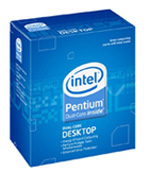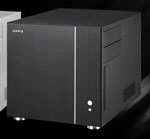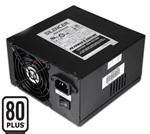Intel HTPC
To be honest, if there's one system in this roundup that is likely to get a lot of comments and criticisms, it's going to be the HTPC configuration. That's not to say that our particular configuration is unreasonable, but in the HTPC market we will invariably encounter a lot of differing opinions about what is necessary and what is not. We detailed our assumptions about the HTPC configurations tin the introduction to the AMD HTPC system. You may want to look back at the considerations. We assume the end user has already selected an HDTV or monitor and a sound system. Very few end users need a TV tuner any more so we are not making that recommendation. We also assume the primary use of the HTPC computer is to play, store, and stream Blu-ray movies and other video entertainment.
| Intel HTPC System | ||
| Hardware | Component | Price |
| Processor | Intel Pentium Dual-Core E5200 Wolfdale (2.5GHz x2 65W 2MB L2 800 FSB) |
$73 |
| Cooling | CPU Retail HSF | $- |
| Video | On-Board | $- |
| Motherboard | Gigabyte GA-E7AUM-DS2H NVIDIA GeForce 9400 | $120 |
| Memory | 4GB DDR2-800 - GSkill F2-6400CL5D-4GBPQ | $37 |
| Hard Drive | Western Digital Caviar Green WD10EACS 1TB SATA 3.0Gb/s Hard Drive - OEM | $105 |
| Optical Drive | LG BD/HD DVD / 16x DVD+/- RW GGC-H20LK | $110 |
| Audio | On-Board | $- |
| Case | Lian LI PC-V350A | $110 |
| Power Supply | PC Power & Cooling Silencer PPCS500 500W ATX12V / EPS12V SLI Ready CrossFire Ready 80 PLUS Certified Active PFC Power Supply - Retail | $50 |
| Base System Total | $605 | |
| Keyboard and Mouse | Logitech Cordless Desktop EX110 Black USB RF Wireless Keyboard & Optical Mouse | $30 |
| Operating System | Microsoft Vista Home Premium OEM | $99 |
| Complete System Bottom Line | $734 | |
 |
As discussed in the Intel entry PC, the E5200 is an excellent value point in the Intel CPU line. Anything lower priced is generally a lot worse in performance, but higher priced CPUs do not gain that much in performance. At the new lower price of $73, the dual-core E5200 is also an excellent match to an NVIDIA 9400 chipset motherboard. It doesn't hurt, either, that the E5200 is rated at 65W, which will help in keeping the HTPC as quiet as possible.
 |
The motherboard for the Intel HTPC is the $135 Gigabyte GA-E7AUM-DS2H featuring the NVIDIA GF9400 chipset. Our motherboard reviews found this chipset and the GF9300 a better choice than G45 in HTPC systems due to superior video playback and overall system performance. Some users have reported that the stock Intel CPU heatsink touches the chipset heatsink on this motherboard and they found the heatsink fit best and worked best by rotating the heatsink 90 degrees. For best results check the fit and best positioning before completing the mount of the heatsink/fan.
 |
The HTPC case is one of those very personal options in building an HTPC computer. Some like the small cube form factor that can easily hide next to books on a shelf, while others prefer the audio component look. While it is fairly expensive for the actual size, we find the cube-like Lian Li PC-V350B a great small aluminum cube. The PC-V350A is the silver version and the PC-V350B is the black version. Both colors sell for the same $110. There is enough space for all the typical HTPC requirements, with good cooling and above all the important blessedly quiet operation. Only a Micro ATX motherboard will fit and there are two 5.25" external drive bays that can open right or left and two internal 3.5" bays for hard drives. Front ports for USB, audio, and FireWire (IEEE 1394) are featured behind a door to keep the appearance sleek and uncluttered. At just 10.3" tall by 11" wide, the V-350A fits in most bookcases just fine, but the depth of 14.7" makes the Lian Li most comfortable on deeper 16" shelves (279mm W x 262mm H x 373mm D).
 |
The little Lian Li is coupled with a robust PC Power & Cooling Silencer 500W power supply that you can currently buy for a bargain $50. You can spend more on a PSU but you will be hard pressed to find a unit as quiet and reliable as the Silencer. It also has enough power for whatever video card you might throw in your HTPC in the future - though high-end GPUs are at odds with the silence most desire from HTPCs.
If you prefer the "audio component" look in your HTPC an excellent alternative is the Silverstone LC13B-E Media Center case selected for the AMD HTPC system. It is worth mentioning that if you choose a full size ATX motherboard for your HTPC, it will fit in the Silverstone but not in the Lian Li cube. The Silverstone is presently on rebate, so the normal $115 price is reduced to $100 after the $10 rebate.
The rest of the components are the same as those found in the AMD HTPC system. For detailed information on the rest of the components chosen for the Intel HTPC please refer to the detailed discussion on the AMD HTPC page.
AMD systems have held the lead for some time in HD video and HTPC boxes. The AMD advantage was large enough that AnandTech hadn't recommended an Intel HTPC build until last December. The NVIDIA GeForce 9300/9400 chipsets have done a lot to level the HD and HTPC playing field - but at a premium price. The Intel HTPC problem was never the CPU, but rather the motherboard chipset. That is the reason we can combine a cheaper Intel CPU with an NVIDIA GF9400 chipset motherboard to create a competent HTPC box.
While we can't tell you HD playback capabilities are completely equal between AMD and Intel today, we can tell you that both HTPC builds provided smooth, stutter-free Blu-ray playback. Certainly that is the primary concern of most HTPC system builders. If you're interested in doing video encoding/transcoding on your HTPC, however, the triple-core Phenom II setup is definitely faster than the E5200; such users would likely want to take a long look at quad-core offerings in all honesty, as encoding is one of the tasks that truly leverage the power of multi-core processors.










66 Comments
View All Comments
v12v12 - Wednesday, March 18, 2009 - link
I agree most of these posts are the nerds-nit-pick special! I'm sorry but if you're whining about $15 here and $20, get a clue and get a REAL JOB or start saving/studying for certs/school and make some real money.This shoe-string budget crap, for a so-called "gamer" box is plain stupidity. If you're hurting over $600-800 MAX limit, sounds like you have your financial PRIORITIES out of whack! Nobody is "gaming" for long with a $600 box. It's a fool's investment and will have you stuck with a sub-par performing machine, rapidly. Oh and don't even think about resale, you're stuck with the low-end junk.
While mirroring the car market: UPSCALE cars/PC builds lose a small percentage of value as soon as you buy them, BUT they hold top value over the coming months Vs this low-mid-level junk that immediately loses an chance of resale value. Have you seen how many stupid people are on Ebay that overbid even for those relic 8800s?!
Who's going to buy your used, non-warranted (many manu's do require proof of purchase these days) 2nd rate card for ~$30 less than RETAIL? Pawning that off to ebay noobs is your only hope to recoupe your losses. Be smart people.
If you're maxing out around $600 = STOP and rethink your finances... $800? Might as well save and get an Icore. Geesh, oh and don't forget about TAXES + initial cost of hardware lol. Not to mention if something goes wrong and you have to RMA = how you gonna afford S/H if you can barely afford a paltry $600-800?
Flame time...
nubie - Tuesday, March 17, 2009 - link
I did get an e5200, for $59.But the motherboard I chose was not using single channel ram, or onboard video. I got an 8600GTS (the GTS is important, it has much more memory bandwidth - 2000mhz DDR3) for $43.
I would like to note that new systems with any sort of budget should be built with a quad-core (unless you need that 4.0ghz clocked Wolfdale for gaming of course.) The Q6600 is only $160 on ebay, and it is a really solid performer.
Kudos to showing how to build a system for people new to the task (and it is infinitely better than letting the newbs pick their own stuff, like 3GB of ram and a 9800pro for example.)
I guess ultimate hard-core system building isn't your cup of tea, maybe we need a "Reader's Rigs" section where we can duke it out with budget builds to see what can really be done. (I would cheat, there are P6N OEM boards for $40 on ebay, and MSI should RMA them for functionality with 45nm processors, it already took a Celeron 440 to 3.33ghz without even a voltage bump!! Ironically Speedstep now starts at the 2.0ghz rating of the chip, so it cycles up less than before.)
Knowname - Tuesday, March 17, 2009 - link
The only future proof quad cores right now are the i7's, even the Phenom 2's will choke under a very taxing 4-core+ program. The proof is in the cache, where even the Phenom's 6mb (shared) is just too little for a fully multicore aware program. It is for this reason that the Core2Quad's 2mb or 4mb cache per core is just TERRIBLE future proofing.Then again, you have to ask yourself... just how much future proofing do I need? When we are in an era of replacing ENTIRE computers every 9 months.
Knowname - Tuesday, March 17, 2009 - link
well my point was it may actually be better for somebody looking to future proof at these prices to buy a e8xxx rather than a q6xxx... JMO.nubie - Wednesday, March 18, 2009 - link
Well, for these prices I would recommend that somebody wait for i7.If they are really on a budget there are 650i OEM motherboards for $40 on ebay, and look for a good deal on a Wolfdale ~$60-70, or overclock the heck out of a Celeron 430/440 (my last two were fine at 3 and 3.33ghz respectively.)
My definition of budget is being out of steady work for ~3 years, so the value for money needs to be very high, and the e5200 and Core2 Celeron are very good in that regard, with 70% overclocks the norm.
My budget systems come in around the $300-350 mark, not the $500+ segment, and yet I would say that they offer the same functionality for gaming and general use (and as I said, I would go Q6600 if I could, probably will when everyone moves to i7 and the prices drop below $100)
7Enigma - Tuesday, March 17, 2009 - link
Great deal I saw on Fatwallet the other day if you are a student (or know someone whom is). This would drop another $35 bucks which would allow for some much needed flexibility especially on the entry-level systems where that difference is ~7% of the build price.Oh to be a student again.....
http://www.microsoft.com/windows/products/windowsv...">http://www.microsoft.com/windows/products/windowsv...
7Enigma - Tuesday, March 17, 2009 - link
Wanted to mention that page also includes Office Ultimate 2007 for $60 if you are an active student. Not bad for someone who needs Office (I personally use OpenOffice).*Seems like the Vista Ultimate might be an upgrade version and not the full version. It's difficult to confirm as the main page that is linked doesn't mention which version but if you click on it it shows upgrade with sp1. Someone less of a hot deal if it's the upgrade only.
7Enigma - Tuesday, March 17, 2009 - link
Anand see if your weight in the tech industry will allow you to aquire for testing one of these puppies:http://www.dailytech.com/Fusionio+Claims+Worlds+Fa...">http://www.dailytech.com/Fusionio+Claim...lds+Fast...
I'd love to see it put through its paces, even though it is in a completely different class ($5000 for lowest model).
scwtlover - Monday, March 16, 2009 - link
For the entry-level AMD system, you recommend G.Skill 800-DDR2 RAM at $37. It's timings are 5-5-5-15 and 1.8V, but it does not come with a heat-spreader. Should we infer that a heat-spreader is unnecessary?mushkin 1.8V memory, with 5-4-4-12 timings and a heat-spreader is available, after rebate, for only $3 more.
And, how significant is 1.8V? At 800-DDR2 Newegg sells OCZ with a heat-spreader and 5-4-4-15 timings, but 2.1V. It's $24 after rebate. Corsair's offering, after rebate, is only $20. It has heat-spreaders, and is 1.9V. The timings are 5-5-5-18? How significant is 12 v. 15 v. 18?
If we look at 1066 DDR2 RAM, the OCZ sticks you recommend cost $28, after rebate. You advise: "Just be sure to look for RAM with better timings if you can afford it." The OCZ is CAS 7, with 7-7-7-20 at 2.0V. For $30, after rebate, Newegg sells OCZ2P10664GK. It's CAS 5, with 5-5-5-18 timings at 2.2V. For $8 more than that, you can get the same RAM plus a bundled XTC memory cooler. How important is voltage versus timings? For $34, that is, $6 more than the OCZ, Newegg sells OCZ Reaper with 5-5-5-18 timings at 2.1V
Wesley Fink - Monday, March 16, 2009 - link
Traditional "Plate stuck on each side" heatspreaders do almost nothing to cool the ram. in fact sometimes they hold in heat and are actually worse than no heatspreader at all. Some more exotic HS designs used in more expensive RAM that is run at higher voltages sometimes do help cool the RAM.The OCZ is DDR2-1066 with slower timings and the 5-5-5 and faster is DDR2-800. The same 7-7-7 1066 memory often runds fine at 5-5-5 at DDR2-800. Higher speed usually means slower timings. If you can find faster RAM like DDR2-1066 at CAS 5 at a similar price then buy it.
As I said in the article quality RAM at the same speed can be selected from any of the major memory providers. Comparing two at the same price look at highest speed combined with reasonable timings. If the two memories are the same price and the same speed then timings (and warranty support) should be your main considerations.
We try to select reasonable choices we have personal experience in using at AT. But there are many rebates in memory right now - and they change daily. You need to be flexible if you are looking for memory that is the best value.